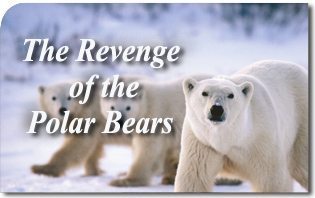 Let’s face it. Times are getting rough for radical ecologists.
Let’s face it. Times are getting rough for radical ecologists.
It is bad enough that their global warming conferences seem to coincide with sub-zero weather patterns. And then there is the problem of fossil fuels. Just when they declare the world has reached “peak oil” production, the energy industry ruins everything and discovers another huge oilfield that pushes back the energy apocalypse another ten or twenty years. Now it seems the polar bears have turned upon the ecologists and thrown them under a biodiesel bus.
That’s right. The polar bears, the poster beasts of the climate change lobby, have refused to cooperate with their own extinction. Reports from up north claim the polar bears are doing just fine.
In fact, their populations are exploding. Locals in Canada’s Nunavut territory report the bears have taken to coming into towns, breaking into cabins and properties and generally wreaking havoc. The growing bear population is becoming a real problem as locals enjoying outdoor activities must be on the lookout for bears and often invite hunters along for protection. Reports in more southern parts of the territory are finding bears appearing where they never have before.
With something like 25,000 polar bears roaming around the northern latitudes, even government sources are asking ecologists to tone down the extinction rhetoric. Nunavut Minister of Environment Daniel Shewchuk stated in a news release that polar bears are not declining, but “thriving,” and that “no known environmental or other factors are currently posing a significant or immediate threat to polar bears overall.”
And yet ecologists are still reporting declining bear populations and the mammal’s impending doom. The Polar Bear Specialist Group (PBSG) among others holds the party line that global warming will ultimately imperil their survival. Polar bear advocates claim that only one of 19 total polar bear subpopulations is currently increasing, three are stable, eight are declining and the remaining seven cannot be determined.
The problem is the evidence on the ground supports a contrary opinion. The polar bears do not seem to care about statistics.
In fact, such statistics are being challenged by scientists and forecasting experts who note that the alarm about the future of polar bears is based on speculative computer model predictions projected many decades in the future and not on actual bear sightings.
Local wildlife management officials present estimates based on local hunters and harvesters who have a feel for how the population is faring and where the polar bears might be found. They question official figures, which are based to a large extent on quick helicopter surveys by scientists which are limited in scope and do not know all the places where the bears can be found.
While many locals acknowledge changes in weather, they claim it is not having negative effects on the polar bear population — and even is a positive factor in keeping bear numbers high. Many locals suspect that the polar bear issue is being used to scare the public about global warming. They complain about reduced hunting quotas that do not reflect the need to cull thriving bear populations.
The inconvenient truth is that polar bears are not endangered. What is endangered is real science which is increasingly becoming politicized science. Meanwhile, much to the embarrassment of the eco-radicals, the revenge of the free-ranging bears continues.

